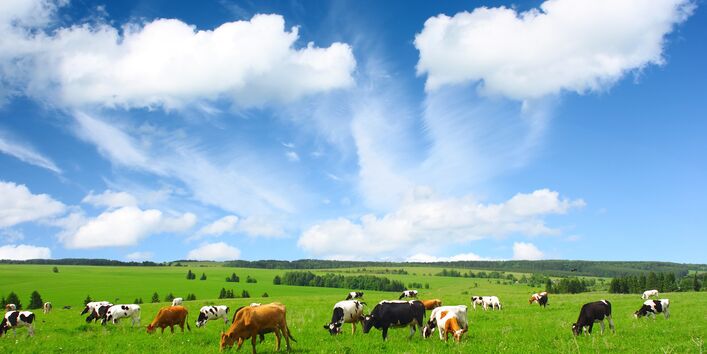Nitrous oxide
Nitrous oxide is a greenhouse gas that does around 300 times more climate damage than carbon dioxide. The main point sources of nitrous oxide are fertilizers containing nitrogen, as well as livestock farming, chemical industry processes and incineration processes. Germany’s greenhouse gases have been declining since the 1990s, an evolution which, in the agricultural sector, is largely attributable to reduced livestock herds in the former East Germany and the consequent reduction in the use of livestock manure. To a lesser extent, this evolution is also attributable to set-aside measures and the consequent reduced use of mineral fertilizers, as well as statutory fertilizer management requirements.
Nonetheless, farming continues to generate substantial amounts of nitrous oxide, in which regard it is necessary to distinguish between direct and indirect nitrous oxide emissions. Direct nitrous oxide emissions are attributable to farming activities per se, secondary to the following: reactive nitrogen inputs from organic and mineral fertilizers; atmospheric nitrogen deposition; nitrogen in the soil from plant residues; and biological nitrogen fixation on the part of legumes. Indirect nitrous oxide emissions are attributable to reactive nitrogen compounds such as nitrate and ammonia entering surrounding natural areas. In the presence of reactive nitrogen compounds, nitrification and denitrification produce nitrous oxide. Crop-production nitrous oxide emissions are mainly attributable to the use of nitrogen fertilizer. In addition to the amount of nitrogen or lime fertilizers used, the amount of greenhouse gas produced is determined by factors such as climate, temperature, soil properties, and fertilizing methods. The high humus content of rezoned mires, fens and cultivated grassland after fertilizer is spread on them results in a particularly high level of nitrous oxide and carbon dioxide (i.e. greenhouse gas) emissions that could be reduced through optimized nitrogen productivity. Nitrogen surpluses could be reduced by pre-determining plant fertilizer needs, factoring in the humus balance, and analyzing the nutrient content of organic fertilizers. In its Sustainability Strategy in 2002, the German government set itself the goal of reducing nitrogen surplus by 3 years to 80 kilograms (kg) per hectare per year by 2010 (Federal Government 2002). This goal was clearly missed. In the update of the Strategy 2016, a new target has been set: on average between 2028 and 2032, the surplus should amount to a maximum of 70 kg per hectare (Federal Government 2016). The extensively revised Fertilizer Ordinance adopted in spring 2017 should help achieve this goal Hence the UBA recommends that a long term target of 50 kilograms of nitrogen per hectare and year be set. The Kyoto Protocol requires the UNFCC signatory states to reduce nitrogen emissions, above and beyond the other reductions called for by the Protocol.
Methane
Methane emissions provoke 25 times more climate damage than carbon dioxide. Most anthropogenic methane is attributable to agricultural and forestry activities. Some 37 per cent of worldwide methane emissions is directly or indirectly attributable to livestock farming from (a) the methane produced by the stomach fermentation processes of ruminants; and (b) the use of sewage sludge as a fertilizer. Wastewater and sewage sludge treatment also result in methane emissions. Unlike nitrous oxide emissions, methane emissions have been on the decline for many years, mainly due to waste storage environmental policy measures and reduced coal mining in Germany. Agricultural methane emissions have dropped owing to reduced livestock herds in the former East Germany – where, however, the effect has not been as great for the other two main sources; and thus more than half of all methane emissions are currently attributable to farming. The most efficient way to reduce methane emissions is to alter human nutritional practices and thus reduce ruminant herds for beef production. Other reduction instruments comprise feeding, modifying cattle slaughtering periods, and installing emission suction systems in cattle barns and for the cleaning thereof.
